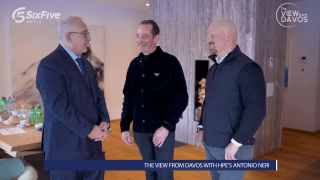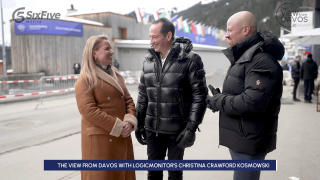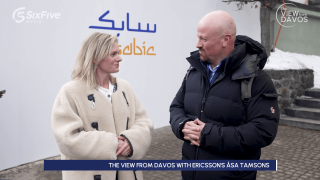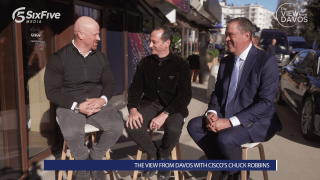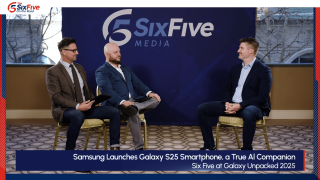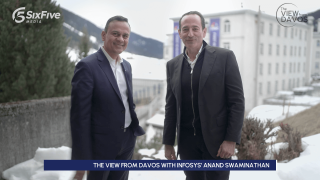On this episode of The Six Five – Insider Edition, hosts Daniel Newman and Patrick Moorhead welcome Kate Woolley, GM of IBM Ecosystem.
Their discussion covers:
- The critical role of IBM ecosystem & how its partners contribute to its accelerating development
- The key features & benefits of IBM’s new Partner Plus program
- How current clients are receiving Partner Plus
- IBM’s dedication to providing maximum value to its clients & partners
- The future expansion relating to strategic partnerships for IBM
It’s a stimulating conversation, and one you won’t want to miss.
Be sure to subscribe to The Six Five Webcast so you never miss an episode.
Watch the episode here:
Listen to the episode on your favorite streaming platforms:
Disclaimer: The Six Five Webcast is for information and entertainment purposes only. Over the course of this webcast, we may talk about companies that are publicly traded and we may even reference that fact and their equity share price, but please do not take anything that we say as a recommendation about what you should do with your investment dollars. We are not investment advisors and we do not ask that you treat us as such.
Transcript:
Patrick Moorhead: Hi, this is Pat Moorhead and we are here for another Six Five Podcast. I am here with my awesome and incredible bestie, Daniel Newman of the Futurum Group. Daniel, how are you doing, my friend?
Daniel Newman: Hey, good morning. Awesome and incredible is an awesome and incredible compliment to start my day. And yes, we are back and I always enjoy these insider podcasts, Pat.
Patrick Moorhead: No, I really do. And today we’re going to talk about something that quite frankly you and I talk about a lot on the show, but also write and research a lot, and that is about ecosystems. It’s my pleasure to introduce IBM’s General Manager of Ecosystems, Kate Woolley. Kate, how are you?
Kate Woolley: Very well. Thanks Pat. Very excited to be here.
Patrick Moorhead: Yeah, welcome to the show. First time on these Six Five. We have interviewed and chatted with some really awesome people from IBM and I’m super excited, particularly talking to you in the virtual green room today.
Kate Woolley: Absolutely, thank you.
Patrick Moorhead: Yeah, so maybe a good place to start, you’ve been with IBM about three years and you’ve been the general manager of the IBM ecosystem for the past year. And by the way, huge word. I mean literally, ecosystem, that’s gigantic, right?
Kate Woolley: Yep.
Patrick Moorhead: Like, “Ecosystem.” It’s big. Can you tell us a little bit about where you were before IBM, how you got there and how you decided on the role of leading this business?
Kate Woolley: So before, as you said, being at IBM for about three years, before I joined IBM, I was with Bain Consulting. So I was a partner in Bain’s technology practice. I led their cloud computing center of excellence and IBM was one of my clients. And so when Arvind was announced as CEO, we talked about me joining. It was really as simple as that.
When I reflect back on those discussions and why I joined, I joined IBM because I believed in the hybrid cloud and AI vision that it had and that it has, I believed in Arvind’s leadership and ultimately kind of believed in the necessity of IBM to be successful as part of the technology landscape. And so I joined as Arvind’s chief of staff for just under two years as he kind of set his strategic agenda, and in that role really got to see firsthand how important the ecosystem is and the growing importance for IBM and for the broader landscape. And so it made a lot of sense. I kind of jumped at the opportunity when that came up to be able to move into the role leading the IBM ecosystem.
Daniel Newman: So as Pat said, it’s a massive role. IBM has so many partnerships. If you pay a little bit of attention to the company, its acquisition strategy, its growth, whether it’s software, whether it’s hardware, I mean IBM is basically a partner with every tech company on the planet in some way, shape or form. And so leading ecosystem is a massive role, massive opportunity. You talked a little bit about the force that drove you there, but this role was also somewhat new and it was created… Was it created for you? Tell us a little bit about that. What was the kind of ultimate decision that IBM needed a GM to lead the ecosystem as opposed to how it traditionally handled it before you arrived?
Kate Woolley: I think you make a great point about IBM being a partner with almost everybody. I think as we looked at that and thought about how we need to do more there and drive more of those connections, it made sense to put it all together. So yes, it all came together under me at the start of last year ranging from, as you say, our resell distributor channel, our biggest strategic partnerships, ISVs, technology partnerships, our GSIs and all of that coming together into the one place. It really was about how do we continue to drive more connections and make it easier for partners because it’s also not just a one-way partnership with a lot of these partners. There are connections across the ecosystem. So we are working with AWS and we have a lot of our offerings on the AWS marketplace where now our resell partners as of last year can actually transact on IBM software through the AWS marketplace. Well, that’s all different types of partners coming together. So it’s really about driving that value and driving more connections.
Patrick Moorhead: Yeah, I’m really glad you used AWS as an example of the changing IBM and how it views the ecosystem, right? I mean, it even turn… Dan and I probably had four or five conversations leading up to it and then Roger Premo pulled us into a room about I think 15 minutes beforehand and I was like, “Hey, here’s what’s going down,” right? I think it’s a good move. And I think not only does it signal a maturing of the marketplace, but I think it also signals a maturing of IBM’s ecosystem strategy.
Arvind has been very public about its role in the ecosystem being key to its growth. You’ve had some divestitures to get focused. You had a really massive acquisition with Red Hat. Going forward, what role do the partners play in IBM’s overall strategy? So how are you positioning? How are you gearing up the ecosystem to play an even bigger role with IBM?
Kate Woolley: I think you hit it there. We’re expecting the ecosystem and our partners to continue to play a bigger role. I think this is driven as well by client needs. When you talk to our clients, and I’m sure you are both talking to them a lot as well, there’s no one vendor that’s going to meet all of the client’s needs. And so that’s why the ecosystem becomes more and more important.
I was actually on the phone earlier this week with one of my peers at one of the Hyperscalers and we were talking about this whole notion of it’s not just about playing nice together, it’s actually about being stronger together and going to our clients together. And so that’s what this ecosystem is about. It’s not about, “Okay, well who are we going to just sit next to?” It’s actually about who we’re going to partner with and do more together with. And so we’re shifting, as you say, continue to invest more, continue to shift more investment into our ecosystem. We introduced a Partner Plus, which is our new Partner program. So how do we continue to make it easier for everybody to engage?
Daniel Newman: Yeah. So maybe that’s a good place to go from here, Kate. I mean, it sounds like you’ve got a lot of energy into the partner, into the ecosystem. But program and creating a programmatic approach is maybe the words I’m looking for. It’s what drives scale. When you’re as big as IBM is, your partners need clarity. They need to know, “How do we become a bigger partner? How do we become a better partner? How do we end up scaling and growing and being more important IBM where the benefits are obvious, the synergies become very visible? So maybe talk about the evolution of the Partner program and what you’re most excited about with the new launch of the Partner Plus program.
Kate Woolley: So we announced IBM Partner Plus at the start of the year. So it’s a complete overhaul of PartnerWorld. I think PartnerWorld might have made its first appearance in 2004 if I’m not mistaken. So it was time for a change. It is about being a complete program across all our partner types. So no matter whether our partners are selling IBM technology, building services around IBM technology or embedding IBM technology, they’re all included in this program. And they’re also recognized that partners aren’t only just doing one of those motions often. So they’re often engaging with us in lots of different ways and that’s sometimes created some unnecessary friction in terms of the way we were engaging with them.
So we have launched the new program, it is all about simplicity. You mentioned our partners need to know how to engage. Our new partners need to know how to engage it. It’s a pretty complex… IBM’s a big place. How do I actually engage with IBM? And so it’s about making sure our partners are an extension of the IBM team. How do we make sure they have the skills? Exactly the same skills as an IBMer would have? How do we make sure we give them the right support, the right benefits they need in order to be successful? How do we bring new [inaudible 00:09:18] really fast and give them what they need, give them the support they need to move faster? So the program is all about simplicity as you said, transparency, predictability, and making it really, really easy.
Patrick Moorhead: So Kate, in a previous life, I was a CRN channel chief. That was a long time ago. That doesn’t make me an ecosystem guru. It just says I was part of the channel and I had a channel program and my partners liked it. It’s one thing to talk about, “Hey, we’re more excited than ever about the ecosystem and about our partners.” So I’m curious, how’s the reaction been to the new Partner program? What metrics can you share or even anecdotes on what they’re saying?
Kate Woolley: Absolutely. So there is excitement around the program, I will start by saying that. But the excitement didn’t just start when we announced it because we actually spent a lot of time with our partners in the design phase of the program. So it was a program that was kind of built with our partners for them.
Patrick Moorhead: Right.
Kate Woolley: Ever since I stepped into this role, I’ve really tried to base everything on listening to partners and listening to what they’re saying. I did a big listening tour when I first came into the role to hear what our partners were thinking and feeling and what they needed from us. The program was built on that. And we also, at the end of last year, spent a lot of time testing all of the details of the incentives and the benefits and everything like that. And we made adjustments based on what we heard from the partners.
So they are very excited. They’re excited about a few things. Some of the themes of what we’re hearing from partners, the first one is around the expertise and how the program is built on expertise. So we made all of our skilling and badging available to partners that is available to IBM as we did that back in October free of charge. Within the first 10 days, three and a half thousand partners signed up to get their new badges. So we’ve seen great engagement in that and they really like that how much they can earn is actually linked to the skills that they have and having the skills in the products that they’re selling.
The other thing they really like is the simplicity of it and the line of sight that it gives them. So they know what they’re earning potential is, they know where they stand, they know how they need to get to the next level, they can access all of this through a single portal. I think that really give… We’ve had people say, “Oh wow, I can actually now explain exactly how my teams make money. I can explain that to them and I can explain that myself.” And so there’s a lot of simplicity in what we’re doing and that’s really resonating with the partners. We’ve got the New Partner Accelerator. We’ve already seen in the manner of hundreds of partners in the first few weeks come in and sign up to be IBM Business Partners, which was a much more cumbersome process in the past.
And so we’re starting to see a lot of traction, seeing a lot of excitement, lot of questions, which means that people are really engaging in it. I think if we hadn’t got a lot of questions, then that would’ve told us that maybe people weren’t paying attention and taking notice of it, but we’re seeing a lot of engagement.
Patrick Moorhead: Yeah, it’s so interesting. Back in the old days, the channel, and again I recognize the difference between the channel and the ecosystem, it takes a lot of strategic thinking to get there because in essence, everybody has to agree on whose strengths and weaknesses, who’s really good at something, who’s in the business of, so you can defer what you’re not doing to somebody else. And that really is a very strategic process and takes some negotiation because sometimes you have to explain to a partner that, “You know, we kind of do this better than you. This is kind of our core business here. You do this, but hey, here’s the best play for both of our companies.” But I’m really happy to hear the early views of success. And quite frankly, Arvind is talking a completely different story and he did it when he first came in. I just wanted to add that comment.
Kate Woolley: Thank you. Thank you.
Daniel Newman: Yeah, so interesting. You mentioned a couple things. Sometimes things like easy and simple and customers having or partners having a clear view of their benefits would seem like table stakes. But I think anyone that’s actually paid attention to partner ecosystems and channels realize it’s never easy. And so while these companies become what I would say interdependent would be the right word, meaning a lot of these companies build significant practices on the relationship and they’re really heavily invested, whether it’s their cold marketing, whether it’s training and development and resources, not having that clear lens can be the difference in which companies lean in more with which partners. And obviously it’s bit of a new idea the last several quarters since Arvind has sort of redirected the hybrid cloud, IT, and hybrid strategy with AI has been really well landed.
By the way we’re recording this on a day where you might be reporting something important like your earnings. So we’re going to get another glimpse of that really soon. But partners being so important, you need to grow the existing, which sounds like a lot of what your program does, is going to make your current partners want to do more, but you also need to keep adding. You need to keep adding new partners. Are you seeing this Partner Plus, is it driving more partners to come on board along with the momentum getting more new partners to join the IBM ecosystem?
Kate Woolley: Yes. So a couple of different ways. I think you mentioned AI and I definitely want to come to that as well because I think that’s a big piece of this as well. But if I start with our resellers, our resell partners, we are seeing partners already engage in our New Partner Accelerator. Kind of in a manner of three weeks, we’ve got over 500 new partners who are there getting white glove support to get up and running. Because what we found actually was the majority of new partners that were coming to IBM are coming with an opportunity in hand. And then they were going through the process to become an IBM partner and then they didn’t really know where to go from there and how to continue to find more opportunities and do more with us.
And so sometimes I’ll say that we had new partners come in and they did one transaction and then that was it. Well, the New Partner Accelerator we have is about changing that story, changing that story so that these new partners can come in, they can become a new partner within a day, which used to take weeks. And then we give them white glove support to say, “Okay, what’s the learning path you are going to go through around IBM products? And then what support can we put behind you around demand generation to find the next set of opportunities? And what support do you need from a technical standpoint?” so that we give them up and running in those first six months. And as soon as they’re productive, they’re on the flywheel. And that’s what the New Partner Accelerator around resell and our service partners is aimed at doing.
You mentioned AI. I think this is a really critical piece as we think about our build partners or those that are embedding IBM technology, our ISV partners. We also have a New Partner Accelerator there. So how do we make sure that they’re able to interact with IBM technology, test it, use it, learn from it, and think about how it can augment their own products? So our Embeddable AI portfolio, that’s all about how do we actually design a portfolio that is really, really good for new partners. How do they take our Watson portfolio, our libraries around natural language processing and actually put it inside their products to make their products better? And so I think that is all about how do we bring on new partners as well? And we’re seeing a lot of traction in that area.
Patrick Moorhead: So it’s interesting, I heard a couple things there that were kind of surprising. I mean, you hear accelerator and yeah, it’s faster, but one day, I mean that’s pretty darn fast. I mean, it takes a day just to get to know each other and shake hands and go get dinner and have a few drinks, but literally up and running in a day. But the other thing you said that was corresponding to that that I found fascinating was this is not just one and done, right? This is, “Let’s get in.” That’s how I think of a partnership, a true partnership versus a transactional type of relationship. So it sounds like not only are you increasing the hit rate between the partners, yourself and the partner, but you’re also getting some of them up and running within a day. I find that fascinating because typically you think of one day it’s transactional, but you’re managing to do both. That’s pretty cool.
Kate Woolley: Thank you. Yes, it’s exciting.
Patrick Moorhead: So the new program has new elements. How is the programming benefiting IBM clients? I mean, it’s easy to understand holistically, but I guess how is it helping them differently with the new program than it did before? I mean, IBM’s had partners for 50 years. We have a new program here with IBM Partner Plus. How is it benefiting clients differently?
Kate Woolley: I’ve mentioned skills a few times. I think it really comes down a lot to the skills that we’re building in our partners. So our clients say to IBM, “We want you to have deeper technical expertise. We want you to have deeper skills.” That’s what they want from our partners as well. And so the program is about really making them an extension of IBM. So if you are in a market talking to a partner or talking to an IBMer, you’re having exactly the same conversation and you’re having a conversation with two people that have gone through exactly the same badging, exactly the same training, has access to exactly the same enablement material, all of that.
I think one of the other elements that underlies all of it, and we touched on it a little bit when we were talking about AWS and some of our strategic partnerships, is the trust. I think for our clients, they now see an IBM ecosystem where a lot of the vendors that they’re dealing with, they trust each other and therefore they’re able to trust that they’re going to get the right solution from their vendors. Their vendors aren’t going to be fighting each other. They’re actually going to be partnering together to deliver more for them. And I think that’s a really important factor that underlies all of this.
Daniel Newman: Yeah, I think it’s pretty clear that when the entire ecosystem works together, ultimately the client that’s receiving the services is the biggest beneficiary. IBM can’t possibly, as you said, deliver all the services that all these enterprises you work with need independently, but there does need to be… Maybe because I’m in the middle of a move, it’s like a general contractor, right? They know all the people that’s required to build the house, but they don’t actually do all the work. And you’re a little bit of… IBM and its total capacity is a little bit like the quarterback or the general contractor. And there are parts that are in-house. There are parts that are external. There’s parts that are going to be delivered very, very much seamlessly from just IBM. And there’s parts where it’s like 5, 6, 7 different ecosystem partners coming in together. And as these environments get more complex, it’s only going to become more important to have that sort of organization and that program. Kate ends up becoming critical.
I know we’re coming towards the end of time here and it’s been a lot of fun talking to you. We’ve got a couple of more questions for you. This will be the last hard one. Then the next one, we’re just going to lay you up a softball to finish. But no, I mean last year I think IBM really made a splash with its AWS announcements. I mean, I think it surprised some people. I think seeing IBM kind of really say, “We get it. We know where we are strong and we know where AWS is strong and we’re going to make our clients even happier and our ecosystem even better by coming together and really joining up and making software available and everything you’re doing.” What can we expect though for 2023? I mean, what’s the big announcement? Let’s just get it out here on the Six Five. We like to break news here. No embargoes. We don’t care. No, I’m kidding. What do we expect for 2023?
Patrick Moorhead: It’s interesting.
Daniel Newman: How do we do better, bigger in ’23?
Kate Woolley: Yes. Before I go there, I’m stealing the house analogy just so you know. I like that.
Patrick Moorhead: Yeah. Yeah. Yeah.
Kate Woolley: [inaudible 00:22:23] stealing.
Daniel Newman: Well, you’ve been trying to build a house for over two years. It was supposed to take one year. You realize how important now it is to have the GC, but actually a good one. So IBM can be the good one in [inaudible 00:22:35].
Patrick Moorhead: By the way, this is therapy for Dan too. He appreciates it, so I appreciate it.
Daniel Newman: I feel better now so go ahead.
Kate Woolley: Yes. But no, 2023, I think, look, with a Hyperscale of partnerships, you’re going to continue to see us do more there around the marketplaces, the SaaS offerings we have. We’re continuing to lean in with our AWS and Azure partnerships. I think with our IBM Consulting we have significant practices built around all of our large strategic partners. So you’ll continue to see us double down there. I think one of the things you will see this year is we have more we can do from an IBM technology standpoint. So as we think about bringing the value of IBM technology with our strategic partners’ products or even embedded inside our strategic partners products, I think there is a lot more to come and you’ll see that from us this year.
Patrick Moorhead: No, that’s exciting. You sure you don’t want to spill one of your next announcements?
Daniel Newman: Come on.
Patrick Moorhead: No, I’m just kidding. We’re analysts. We’re not the press. We have fun-
Daniel Newman: No. We’re curious, Pat.
Patrick Moorhead: Breaking embargoed information is not our currency.
Daniel Newman: Yeah. Yeah.
Patrick Moorhead: But Kate, want to thank you so much for coming on. I think a great way to end is a reflection to the past. Although we just talked a little bit about the future, we’d like to know what are you most proud of that you and the team did around partners in 2022? And again, I’ll give you one final opportunity to talk about what you’re going to do in ’23.
Kate Woolley: Okay. I’m really proud of the kind of unrelenting focus and investment that we’ve put behind the IBM ecosystem. I think one of you said the new IBM, I mean this has been a shift for IBM. And there, from top to bottom of the company, I am proud of how everyone has put their thoughts behind that. It’s been incredible. I’m very proud of Partner Plus and what we launched there. That was a lot of work that the team put in as we led into that announcement.
I think for 2023, we’ve talked about a lot of the things that I really want to focus on. It’s about how do we continue to collaborate more and drive more of those connections so they’re not just one way partnerships, but they’re partnerships across the ecosystem. Because I think that’s what our clients want. As we think about their large system integrators, their Hyperscalers, their strategic partners, and their relationship with IBM, they want to see more of that come together. And so collaboration. And then I want to keep focused in 2023, focused on what we’re doing, focused on what we’re doing with our strategic partners, focused on how we are getting our ecosystem sellers on the ground, supporting the ecosystem in the right way, focused on Partner Plus and getting that up and running and really firing on all cylinders. So it’s really all about collaboration and driving focus in the team.
Daniel Newman: Well, Kate, thank you so much for joining us here on the Six Five. It’s been a pleasure chatting to you. A lot going on in the ecosystem and a lot for our community to continue to watch in 2023.
Kate Woolley: Thank you both for having me. It’s been great.
Daniel Newman: All right, everybody, this is it for this episode. Great conversation about IBM and it’s ecosystem. We are going to be closely watching what the company is doing in this space as IBM does continue to turn the ship with its focus on hybrid and AI and automation. These have certainly yielded a good result so far.
If you like what you heard, hit that subscribe button. We’d love to have you as part of the Six Five community. For all of our shows, our insiders, and of course our weekly Friday episode, follow us across all the social platforms. You know we love to have you there too. But for this episode, for Patrick and myself, it’s time to say goodbye. We’ll see you later. Thanks for tuning in.


